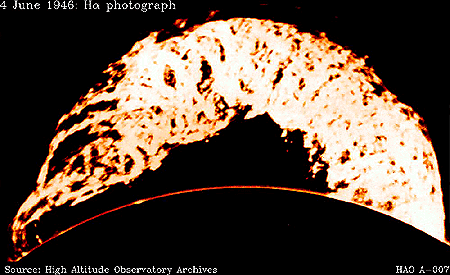
One of the largest prominences ever seen.
Photographed in Halpha in 1946 almost 30 years after Lockyers death.
He designed a method by which prominences could be observed without the aid of a total eclipse.
A french astronomer, Jules Janssen, independently demonstarted the same technique. They were both honoured by the striking of a medal in commemoration of their discovery by the french Academy of Sciences.
Lockyer suggested that solar prominences where upheavals from a layer around the Sun that he named the chromosphere. This work led to the discovery of Helium in 1868.
Other solar work included the study of Doppler shifts to determine the speed of ejection of solar flares and the use of spectroscopic techniques to determined the temperature of the solar surface and of sunspots.

One of the largest prominences ever seen.
Photographed in Halpha in 1946 almost 30 years after Lockyers death.
| Archaeoastronomy | Astrophysics | Eclipses | Helium | Knighthood |
| NATURE | Observatory | Sir Norman Lockyer | Stellar Research | Teacher |